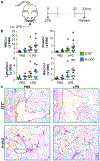Disruption of hepatocyte Sialylation drives a T cell-dependent pro-inflammatory immune tone
- PMID: 32222873
- PMCID: PMC7266343
- DOI: 10.1007/s10719-020-09918-y
Disruption of hepatocyte Sialylation drives a T cell-dependent pro-inflammatory immune tone
Abstract
Through the catalysis of α2,6-linked sialylation, the enzyme ST6Gal1 is thought to play key roles in immune cell communication and homeostasis. Of particular importance, glycans with terminal α2,6-sialic acids are known to negatively regulate B cell receptor signaling and are associated with an immunosuppressive tumor microenvironment that promotes T cell anergy, suggesting that α2,6-sialic acids are a key immune inhibitory signal. Consistent with this model, mice harboring a hepatocyte-specific ablation of ST6Gal1 (H-cKO) develop a progressive and severe non-alcoholic fatty liver disease characterized by steatohepatitis. Using this H-cKO mouse, we have further discovered that loss of hepatocyte α2,6-sialylation not only increases the inflammatory state of the local tissue microenvironment, but also systemic T cell-dependent immune responses. H-cKO mice responded normally to innate and passively induced inflammation, but showed significantly increased morbidity in T cell-dependent house dust mite-antigen (HDM)-induced asthma and myelin oligodendrocyte glycoprotein (MOG) peptide-induced experimental autoimmune encephalomyelitis (EAE). We further discovered that H-cKO mice have a profound shift toward effector/memory T cells even among unchallenged mice, and that macrophages from both the liver and spleen expressed the inhibitory and α2,6-sialic acid-specific glycan binding molecule CD22. These findings align with previously reported pro-inflammatory changes in liver macrophages, and support a model in which the liver microenvironment sets a systemic immune tone that is regulated by tissue α2,6-sialylation and mediated by liver macrophages and systemic T cells.
Keywords: Asthma; EAE; Glycobiology; IgG; Inflammation; Liver; Macrophage; ST6Gal1; Sialic acid; Sialylation; T cell.
Conflict of interest statement
Conflict of interest
The authors declare that they have no conflicts of interest with the contents of this article.
Figures








References
Publication types
MeSH terms
Substances
Grants and funding
LinkOut - more resources
Full Text Sources
Other Literature Sources

